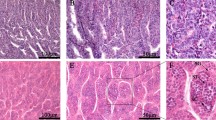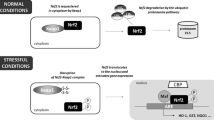Abstract
Apoptosis serves to protect normal cells during the processes of development, aging, tissue homeostasis, immunity, and inflammation. Molecules such as caspases, the Bcl-2 family proteins, cytochrome c, APAF-1, and apoptotic endonucleases are concerned with and regulate different stages of apoptosis. DNA fragmentation factor (DFF) is a key final molecule in chromosomal DNA fragmentation during the last step of apoptosis, and is a heterodimeric complex consisting of alpha/inhibitor of caspase-activated DNase (DFFA/ICAD) and beta/caspase-activated DNase (DFFB/CAD) subunits. DFFB/CAD is normally combined with the inhibitor, DFFA/ICAD, in healthy cells. However, after cleavage of the DFF complex by effector caspases, DFFB/CAD acts as an apoptotic nuclease and induces DNA fragmentation in apoptotic cells. The study of DFF proteins is focused on the roles of the apoptotic pathway in mammals. However, gene expression and functions under immune stimulation are not well known in other species. In the present study, we first characterized teleost DFFA/ICAD and DFFB/CAD from rock bream at the molecular level and analyzed the transcriptional expression pattern under immune challenges, to understand their role in immunity. These putative proteins have shown conserved domains and interaction sites orthologous to those of other species. High mRNA expression of both genes was found in the gills and blood of tissues involved in the immune response. The increased expression of DFF genes upon bacterial and viral stimulation was confirmed by qPCR analysis. DFFA/ICAD and DFFB/CAD of rock bream may play a pivotal role in apoptosis and may be involved in host immunity against bacterial and viral infection.






Similar content being viewed by others
References
Barber GN (2001) Host defense, viruses and apoptosis. Cell Death Differ 8:113–126
Bayascas JR, Yuste VJ, Sole C, Sanchez-Lopez I, Segura MF, Perera R, Comella JX (2004) Characterization of splice variants of human caspase-activated DNase with CIDE-N structure and function. FEBS Lett 566:234–240
Benedict CA, Norris PS, Ware CF (2002) To kill or be killed: viral evasion of apoptosis. Nat Immunol 3:1013–1018
Bols NC, Brubacher JL, Ganassin RC, Lee LEJ (2001) Ecotoxicology and innate immunity in fish. Dev Comp Immunol 25:853–873
Boya P, Pauleau AL, Poncet D, Gonzalez-Polo RA, Zamzami N, Kroemer G (2004) Viral proteins targeting mitochondria: controlling cell death. Biochim Biophys Acta 1659:178–189
Bustin SA et al (2009) The MIQE guidelines: minimum information for publication of quantitative real-time PCR experiments. Clin Chem 55:611–622
Chen D, Stetler RA, Cao G, Pei W, O’Horo C, Yin XM, Chen J (2000) Characterization of the rat DNA fragmentation factor 35/Inhibitor of caspase-activated DNase (Short form). The endogenous inhibitor of caspase-dependent DNA fragmentation in neuronal apoptosis. J Biol Chem 275:38508–38517
Danial NN, Korsmeyer SJ (2004) Cell death: critical control points. Cell 116:205–219
Elmore S (2007) Apoptosis: a review of programmed cell death. Toxicol Pathol 35:495–516
Elvitigala DA et al (2012) Caspase 3 from rock bream (Oplegnathus fasciatus): genomic characterization and transcriptional profiling upon bacterial and viral inductions. Fish Shellfish Immunol 33:99–110
Elvitigala DA, Premachandra HK, Whang I, Yeo SY, Choi CY, Noh JK, Lee J (2015) Molecular cloning, expression and functional characterization of a teleostan cytokine-induced apoptosis inhibitor from rock bream (Oplegnathus fasciatus). Dev Comp Immunol 52:48–57
Enari M, Sakahira H, Yokoyama H, Okawa K, Iwamatsu A, Nagata S (1998) A caspase-activated DNase that degrades DNA during apoptosis, and its inhibitor ICAD. Nature 391:43–50
Engidawork E, Gulesserian T, Yoo BC, Cairns N, Lubec G (2001) Alteration of caspases and apoptosis-related proteins in brains of patients with Alzheimer’s disease. Biochem Biophys Res Commun 281:84–93
Fukushima K, Kikuchi J, Koshiba S, Kigawa T, Kuroda Y, Yokoyama S (2002) Solution Structure of the DFF-C Domain of DFF45/ICAD. A structural basis for the regulation of apoptotic DNA fragmentation. J Mol Biol 321:317–327
Glowacka E, Banasik M, Lewkowicz P, Tchorzewski H (2002) The effect of LPS on neutrophils from patients with high risk of type 1 diabetes mellitus in relation to IL-8, IL-10 and IL-12 production and apoptosis in vitro. Scand J Immunol 55:210–217
Hanus J, Kalinowska-Herok M, Widlak P (2008) The major apoptotic endonuclease DFF40/CAD is a deoxyribose-specific and double-strand-specific enzyme. Apoptosis 13:377–382
Heumann D, Roger T (2002) Initial responses to endotoxins and Gram-negative bacteria. Clin Chim Acta 323:59–72
Honig LS, Rosenberg RN (2000) Apoptosis and neurologic disease. Am J Med 108:317–330
Jeong JM, Kim JW, Park HJ, Song JH, Kim DH, Park CI (2011) Molecular cloning and characterisation of the rock bream, Oplegnathus fasciatus, Fas (CD95/APO-1), and its expression analysis in response to bacterial or viral infection. Results Immunol 1:11–17
Jung MH, Nikapitiya C, Song JY, Lee JH, Lee J, Oh MJ, Jung SJ (2014) Gene expression of pro- and anti-apoptotic proteins in rock bream (Oplegnathus fasciatus) infected with megalocytivirus (family Iridoviridae). Fish Shellfish Immunol 37:122–130
Kasthuri SR, Wan Q, Whang I, Lim BS, Yeo SY, Choi CY, Lee J (2014) Functional characterization of the evolutionarily preserved mitochondrial antiviral signaling protein (MAVS) from rock bream, Oplegnathus fasciatus. Fish Shellfish Immunol 40:399–406
Kawane K et al (1999) Structure and promoter analysis of murine CAD and ICAD genes. Cell Death Differ 6:745–752
Kutscher D, Pingoud A, Jeltsch A, Meiss G (2012) Identification of ICAD-derived peptides capable of inhibiting caspase-activated DNase. FEBS J 279:2917–2928
Lancellotti M, Pereira RF, Cury GG, Hollanda LM (2009) Pathogenic and opportunistic respiratory bacteria-induced apoptosis. Braz J Infect Dis 13:226–231
Lichtenfels AJ, Lorenzi-Filho G, Guimaraes ET, Macchione M, Saldiva PH (1996) Effects of water pollution on the gill apparatus of fish. J Comp Pathol 115:47–60
Liu X, Zou H, Slaughter C, Wang X (1997) DFF, a heterodimeric protein that functions downstream of caspase-3 to trigger DNA fragmentation during apoptosis. Cell 89:175–184
Livak KJ, Schmittgen TD (2001) Analysis of relative gene expression data using real-time quantitative PCR and the 2(−∆∆C(T)) Method. Methods 25:402–408
McCarty JS, Toh SY, Li P (1999a) Multiple domains of DFF45 bind synergistically to DFF40: roles of caspase cleavage and sequestration of activator domain of DFF40. Biochem Biophys Res Commun 264:181–185
McCarty JS, Toh SY, Li P (1999b) Study of DFF45 in its role of chaperone and inhibitor: two independent inhibitory domains of DFF40 nuclease activity. Biochem Biophys Res Commun 264:176–180
Mukae N, Enari M, Sakahira H, Fukuda Y, Inazawa J, Toh H, Nagata S (1998) Molecular cloning and characterization of human caspase-activated DNase. Proc Natl Acad Sci 95:9123–9128
Munshi N, Fernandis AZ, Cherla RP, Park IW, Ganju RK (2002) Lipopolysaccharide-induced apoptosis of endothelial cells and its inhibition by vascular endothelial growth factor. J Immunol 168:5860–5866
Park HH (2015) Structural insight into CIDE domains: the Janus face of CIDEs. Apoptosis 20:240–249
Premachandra HK et al (2012) Cystatin B homolog from rock bream Oplegnathus fasciatus: genomic characterization, transcriptional profiling and protease-inhibitory activity of recombinant protein. Comp Biochem Physiol B 163:138–146
Sacco R et al (2003) Antiapoptotic regulation by hepatitis C virus core protein through up-regulation of inhibitor of caspase-activated DNase. Virology 317:24–35
Sakahira H, Enari M, Nagata S (1998) Cleavage of CAD inhibitor in CAD activation and DNA degradation during apoptosis. Nature 391:96–99
Sakahira H, Iwamatsu A, Nagata S (2000) Specific chaperone-like activity of inhibitor of caspase-activated DNase for caspase-activated DNase. J Biol Chem 275:8091–8096
Whang I et al (2011a) Molecular characterization and expression analysis of Cathepsin B and L cysteine proteases from rock bream (Oplegnathus fasciatus). Fish Shellfish Immunol 30:763–772
Whang I et al (2011b) Characterization and expression analysis of a goose-type lysozyme from the rock bream Oplegnathus fasciatus, and antimicrobial activity of its recombinant protein. Fish Shellfish Immunol 30:532–542
Widlak P, Garrard WT (2006) Unique features of the apoptotic endonuclease DFF40/CAD relative to micrococcal nuclease as a structural probe for chromatin. Biochem Cell Biol 84:405–410
Widlak P, Garrard WT (2009) Roles of the major apoptotic nuclease-DNA fragmentation factor-in biology and disease. Cell Mol Life Sci 66:263–274
Xaus J et al (2000) LPS induces apoptosis in macrophages mostly through the autocrine production of TNF-alpha. Blood 95:3823–3831
Xiang Z, Qu F, Qi L, Ying T, Li J, Shu X, Yu Z (2014) Cloning and characterization of an apoptosis-related DNA fragmentation factor (DFF) from oyster Crassostrea hongkongensis. Fish Shellfish Immunol 38:119–126
Zhang JH, Xu M (2000) DNA fragmentation in apoptosis. Cell Res 10:205–211
Zhou P, Lugovskoy AA, McCarty JS, Li P, Wagner G (2001) Solution structure of DFF40 and DFF45N-terminal domain complex and mutual chaperone activity of DFF40 and DFF45. Proc Natl Acad Sci USA 98:6051–6055
Acknowledgments
This research was a part of the project titled ‘Fish Vaccine Research Center’, funded by the Ministry of Oceans and Fisheries, Korea.
Author information
Authors and Affiliations
Corresponding author
Ethics declarations
Conflict of interest
Authors declared no conflict of interest on this manuscript.
Ethical approval
Fish care and challenge experiments were reviewed and approved by Animal Care and Use Committee Jeju National University.
Rights and permissions
About this article
Cite this article
Lee, S., Whang, I., Wan, Q. et al. Profiles of teleost DNA fragmentation factor alpha and beta from rock bream (Oplegnathus fasciatus): molecular characterization and genomic structure and gene expression in immune stress. Genes Genom 38, 193–204 (2016). https://doi.org/10.1007/s13258-015-0359-1
Received:
Accepted:
Published:
Issue Date:
DOI: https://doi.org/10.1007/s13258-015-0359-1




